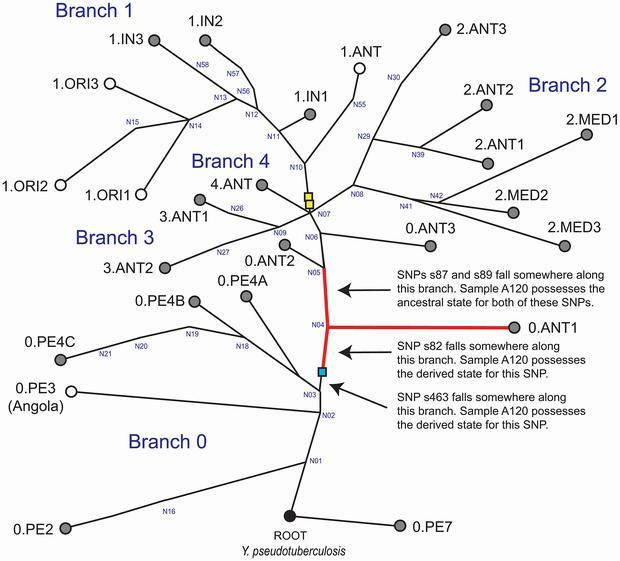'Pestilence', widespread outbreaks of deadly contagious disease, are known throughout history. In popular translations of the Christian Bible, Pestilence is one of the Four Horsemen of the Apocalypse.
Today we call them pandemics but they are nothing like plagues of old, when up to 33% of a population was eradicated, like during the Black Death of the 14th century.
Today we recognize that the major plagues were different from other pandemics and even pestilences. The third major plague in the late 1800s left microbiological evidence that the causing agent was the bacterium Yersinia pestis and now the researchers who confirmed that the Bubonic Plague was also caused by Y. pestis also implicate it in the Justinian Plague which began around the middle of the 6th century A.D.
How? Researchers performed DNA analyses in the early medieval cemetery of Aschheim in Bavaria, which meant that it crossed the Alps and infected people there. Their DNA fingerprinting determined Asia was the likely origin. The microbiological origin of the Justinian plague is up for debate because biovars based upon phenotypic properties for Y.Pestis only include three groups. The current paper says that does not account for mutations and their new global phylogeny based upon single nucleotide polymorphisms (SNPs) is identified from the genomes of 133 global strains.

Global phylogeny for Y. pestis. This global phylogeny for Y. pestis includes four major branches (0–4) and is rooted with Y. pseudotuberculosis, the ancestor of Y. pestis. The identities of many of the major nodes defined by Cui et al. are presented in blue text. Circles represent specific populations; populations highlighted in gray have, to date, only been found in Asia. Note that the location where strain Angola was isolated, which is the sole representative of population 0.PE3, is unknown. The phylogenetic position of Mongolian strain MNG 2972 is indicated with the blue box (see text). Five previously identified key SNPs were utilized in the current study: s545, which occurs along the branch between nodes N06 and N07 (not shown); s87 and s89; which occur along the branch between N04 and N05; s82, which occurs along the branch between the branching point of strain MNG 2972 and N04; and s463, which occurs along the branch between the branching point of strain MNG 2972 and N03. It is known that these SNPs occur along these specific branches but the exact position and order of these SNPs along each branch is unknown. Sample A120 possesses ancestral states for SNPs s87, s89, and s545; and derived states for SNPs s82 and s463. Thus, the position of sample A120 in this phylogeny is along the branch between the branching point of strain MNG 2972 and N04, along branch N04-N05, along the branch from N04 to 0.ANT1 (red branches), or along one of the sub-branches within 0.ANT.1 (not shown). The phylogenetic positions of strains from the second pandemic are indicated with the yellow boxes according to Cui et al. . The basal node for the 1.ORI group, which caused the third pandemic, is N14. Credit:
doi:10.1371/journal.ppat.1003349
The Aschheim cemetary has 438 individuals and a large number of double and multiple burials clustering in the second half of the sixth century. In an earlier study [15], we reported isolation of Y. pestis DNA from two individuals from Aschheim. Using contamination controls and authentication of results recommended for studies that describe the detection of pathogen DNA in human remains from archeological sites, they say they have confirmed that Y. pestis was responsible for the Plague of Justinian. They were able to genotype the Y. pestis DNA present in samples from one individual using five key SNPs from the recent global Y. pestis phylogenies.
"For a long time scholars from different disciplines have intensively discussed about the actual etiological agents of the past pandemics. Only ancient DNA analyses carried out on skeletal remains of plague victims could finally conclude the debate," said Dr. Barbara Bramanti of the Palaeogenetics Group at the Institute of Anthropology at Johannes Gutenberg University Mainz.
Plagues today are not as damaging and their primary vector is most often Xenopsylla cheopis (the oriental rat flea). Kill 'em if you see 'em.
Citation: Harbeck M, Seifert L, Hänsch S, Wagner DM, Birdsell D, et al. (2013) Yersinia pestis DNA from Skeletal Remains from the 6th Century AD Reveals Insights into Justinianic Plague. PLoS Pathog 9(5): e1003349. doi:10.1371/journal.ppat.1003349






Comments